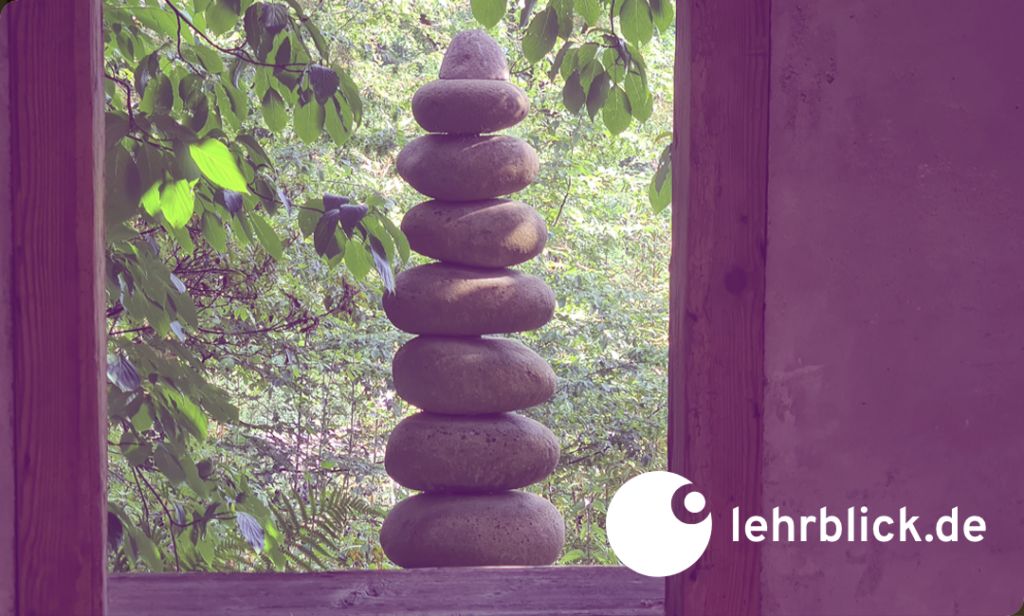The degree of perceived stress in our society has been continually rising for years – and that includes the academic arena. One possible solution is to strengthen our mental resilience. In the following, we introduce a method for how this can be achieved.
Stress in teaching
It is hardly surprising that mindfulness has been subject to what can only be described as a hype over the last few years: the degree of perceived stress in our society rises constantly every year, particularly in the working domain. New challenges like the advancing digitisation or the dissolving of clear boundaries between work life and private life can constitute stress factors for employees. As a group, teachers are particularly susceptible to stress (Janssen et al., 2020). Student populations are likewise affected by a higher level of stress than the general population. Since the COVID-19 pandemic in particular, health reports have referred to a rising prevalence of depression, anxiety and self-reported stress among students (Gilan & Helmreich, 2022). Universities are increasingly being called to strengthen the academic resilience of staff and students in the university arena so that they stay healthy and are able to cope with stress adequately.
One important component for reinforcing academic resilience could be an old philosophy of life that was originally Buddhist but now shows itself in modern garb – mindfulness.
What is mindfulness?
The definition of the term mindfulness that is most well-known and most commonly used in the west at the moment came from the molecular biologist and mindfulness researcher Jon Kabat-Zinn, who describes mindfulness as experiencing the present moment in non-judgemental awareness and therefore as the ability to know what is happening while it is happening (Kabat-Zinn, 2015).
The term essentially comprises two aspects:
- awareness – paying attention to the present moment – and
- acceptance – a mindset that is open to and accepting of the object of perception at that moment.
Everything that can be perceived can serve as an object of attention, including physical sensations, sounds, feelings, mental activity and all other internal and external stimuli. When these stimuli are perceived, the focus is on the type of perception, that is to say, a non-judgemental mindset: unpleasant physical sensations like tension or pins and needles are accepted and perceived in the same way as pleasant states, such as listening to beautiful birdsong.
The following interview with J. Kabat-Zinn (2016) provides a detailed look at the concept of mindfulness:
How can you practise mindfulness?
Mindfulness can be practised formally, that is, in the form of specific mindfulness exercises like breathing or body scan meditations. With exercises like these, people who are inexperienced in the practice of mindfulness particularly benefit from verbal guidance by another person. Guided meditation offers a context and a focus to help the mind’s lack of centredness to become centred. What is also suitable for new practitioners is exercises that focus on the body or the breath so that they can ground themselves in the present moment and focus on it, such as
- body scan meditations (example of mindfulness exercises that focus on the body)
- sitting meditations (example of mindfulness exercises that focus on the breath).
In addition, mindfulness can also be practised informally, that is, while you are doing everyday activities like washing up, brushing your teeth or waiting for someone or something. The long-term goal of mindfulness practice is to integrate a present and accepting mindset into your everyday life for the long term. Paradoxically, the goal of mindfulness exercises is not primarily to reduce stress, as this would involve manipulating the present moment – in actual fact, the reduction in the stress level happens as a by-product of a mindset that accepts the present moment. In that sense, mindfulness is not a relaxation technique either, as tension around the back of the neck, for instance, is perceived in an accepting and non-judgemental way and is not specifically changed or worked on.
To sum up, it is therefore the ability to remain present in that moment that is cultivated in mindfulness practice, regardless of whether that moment is experienced as pleasant or unpleasant.
Why is mindfulness important?
Over the past few years, there has been a huge increase in the number of scientific studies investigating the effects of regular mindfulness practice: according to these studies, the effect of regular mindfulness exercises ranges from improving mental health parameters such as well-being, self-efficacy, life satisfaction and stress reduction skills, to achieving somatic effects like reducing the levels of the stress hormone cortisone in the blood or reducing sensitivity to pain (Grossman et al., 2004).
Mindfulness practitioners also report a reduction in the level of brooding, less anxiety or increased relaxation.
Mindfulness researchers assume that mindfulness has a non-specific effect on the practitioner’s entire body and can thus achieve a wide range of effects. In principle, therefore, mindfulness is suitable for many people.

Mindfulness in teaching?
For one thing, the question regarding mindfulness in teaching arises if you look at the above-average levels of stress among teachers as an occupational group, but for another, you can also see the connection between teachers’ stress levels and the effects on student performance: high levels of perceived stress in teachers are associated with less self-efficacy and lower socio-emotional skills among the learners, for example. Other scientific findings expressly refer to the negative impact of teachers’ stress levels on students’ commitment and their understanding of the subject matter (Emerson et al., 2017).
In contrast, if teachers practise mindfulness regularly, this can have positive effects on both the teachers themselves and on those they are teaching: in classes taught by teachers who practise mindfulness, for example, an improvement was not only observed in the educational skills of those teachers but also in the students’ learning success. Researchers assume that the teachers’ mindfulness practice has an effect on their well-being, which, in turn, is reflected in the effectiveness of their transfer of knowledge and in the students’ well-being and learning success (Lave & Berkovich-Ohana, 2020).
Both formal and informal mindfulness exercises can be integrated into the day-to-day at work and into your teaching routine. Short, mindful breaks of three or five minutes are a good way to remind yourself regularly of the present moment in the hectic day-to-day at work and to deal more calmly with the tasks that are pending, for example:
- 3-minute mindfulness (example of a three-minute break; extract from our course entitled “Achtsamkeit für Mitarbeitende” [Mindfulness for staff])
- 5-minute break (five-minute guided meditation with Jon Kabat-Zinn).
For those with advanced experience in mindfulness, it can also be integrated informally at work – consciously enjoying a cup of coffee instead of drinking it absent-mindedly, noticing the feeling of the water on your skin when washing your hands, or staying more present in conversations with colleagues. Setting a timer on your mobile or PC that keeps reminding you to take short mindfulness breaks can also help you to structure your daily routine at work more mindfully.
Our conclusion
Regular mindfulness practice can represent a valuable tool – not only for the individual themselves but also for anyone they interact with. Teachers particularly benefit from the important role of the multipliers for their students. Practising mindfulness takes time and patience, but establishing it long-term in your own life can help you deal with challenging situations more calmly and cope with stress with a greater degree of resilience both in your private life and your day-to-day at work. Teachers have the function of a role model and can multiply the positive effects of their practice in that their mindset of mindfulness also has an effect on the students’ environment.
Mindfulness only comes alive of you actually experience it. Your own mindfulness practice can start right at this moment. You don’t need any real tools or any particular posture. You can have your first experience of mindfulness in every moment that you perceive with awareness – now, for example.
References
Emerson, L.-M., Leyland, A., Hudson, K., Rowse, G., Hanley, P. & Hugh-Jones, S. (2017). Teaching Mindfulness to Teachers: a Systematic Review and Narrative Synthesis. Mindfulness, 8(5), 1136–1149. https://doi.org/10.1007/s12671-017-0691-4
Gilan, D. & Helmreich, I. (2022, 7. Dezember). Was tun gegen Stress im akademischen Arbeitsumfeld? Forschung & Lehre. https://www.forschung-und-lehre.de/management/was-tun-gegen-stress-im-akademischen-arbeitsumfeld-5234
Grossman, P., Niemann, L., Schmidt, S. & Walach, H. (2004). Mindfulness-based stress reduction and health benefits. Journal of Psychosomatic Research, 57(1), 35–43. https://doi.org/10.1016/S0022-3999(03)00573-7
Janssen, M., Heerkens, Y., van der Heijden, B., Korzilius, H., Peters, P. & Engels, J. (2020). A study protocol for a cluster randomised controlled trial on mindfulness-based stress reduction: studying effects of mindfulness-based stress reduction and an additional organisational health intervention on mental health and work-related perceptions of teachers in Dutch secondary vocational schools. Trials, 21(1), 376. https://doi.org/10.1186/s13063-020-4189-3
Kabat-Zinn, J. (2015). Mindfulness. Mindfulness, 6(6), 1481–1483. https://doi.org/10.1007/s12671-015-0456-x
Lavy, S., Berkovich-Ohana, A. (2020). From Teachers’ Mindfulness to Students’ Thriving: The Mindful Self in School Relationships (MSSR) Model. Mindfulness, 11(10), 2258–2273. https://doi.org/10.1007/s12671-020-01418-2
Suggestion for citation of this blog post
Koch, V. & Zinzius, L. (2023, June 29). Achtsamkeit in der Lehre: Wie bewusste Präsenz die Hochschullehre bereichert. Lehrblick – ZHW Uni Regensburg. https://doi.org/10.5283/10.5283/ZHW.20230629.EN

Verena Koch
Verena Koch is a psychologist and yoga teacher, and in addition to her full-time clinical work with family systems, she is dedicated to a topic that is close to her heart: mindfulness. In the way she works, she combines her background knowledge of psychology with many years of practice in mindfulness and yoga to teach successful stress management.

Lukas Zinzius
Lukas Zinzius is a psychologist and keen surfer, and has been holding workshops on mindfulness all over Germany for three years. His goal is to spread the positive effects of mindfulness practice in a practical and practicable way for as many people as possible,





